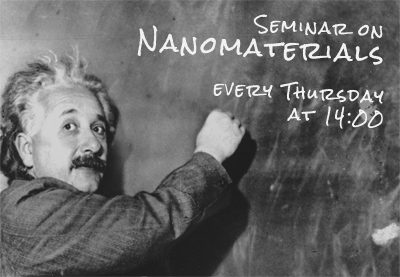Nanoseminar
Group of Structure analysis at the Department of Condensed Matter Physics
of Charles University and MGML has a pleasure to invite you to attend the seminar on nanomaterials: Physics, Technology, Applications
on 27th March 2025 at 14:00
at Faculty of Mathematics and Physics of Charles University, Ke Karlovu 5, 121 16 Praha 2
Lecture room F2
Zuzana Vlčková
J. Heyrovský Institute of Physical Chemistry, v.v.i., Academy of Sciences of the Czech Republic
Nanomaterials for Energy Conversion and Storage Applications
Zuzana Vlčková » Nanomaterials for Energy Conversion and Storage Applications
J. Heyrovský Institute of Physical Chemistry, v.v.i., Academy of Sciences of the Czech Republic
Location: F2
The development of efficient and sustainable energy technologies is crucial to meeting the growing global demand for clean energy. Nanomaterials play a key role in enhancing the performance of energy conversion and storage systems by offering improved efficiency, stability, and scalability. This presentation will focus on recent advances in nanomaterials (doped diamond, silicon) for solar cells, lithium-ion batteries (LIBs), and aqueous batteries (ABs).
Boron-doped diamond (BDD) has emerged as a promising material for both solar and battery applications due to its exceptional electrical conductivity, chemical stability, and wide electrochemical potential window. In solar cells, BDD functions as an efficient p-type semiconductor, improving charge carrier mobility and reducing recombination losses, thus enhancing overall cell efficiency. In aqueous batteries, BDD's robustness makes it an ideal electrode material, especially in highly corrosive water- in-salt electrolytes, which expand the electrochemical stability window beyond the conventional 1.23 V of dilute aqueous solutions. Compared to other carbon-based materials, BDD offers superior resistance to degradation, making it suitable for long-term cycling stability in energy storage applications.
Nanostructured silicon is considered one of the most attractive anode materials for high-energy-density LIBs due to its high capacity (3579 mAh/g), which significantly surpasses conventional
graphite (372 mAh/g), and its extended cycle life compared to bulk Si anodes. By increasing the surface area-to-volume ratio of Si, internal strain during lithiation is reduced, electrolyte accessibility is increased, and the volumetric energy density of the composite anode decreases. However, its large volume expansion during (de)lithiation (over 300%) leads to mechanical instability and capacity fading. To mitigate these effects, silicon is typically used in composite anodes combined with carbon or conductive polymer matrices. Additionally, this lecture will discuss the role of in situ Raman spectroelectrochemistry as a powerful tool for real-time characterization of anode materials in both battery and solar cell applications.
*corresponding author: e-mail: zuzana.vlckova@jh-inst.cas.cz


